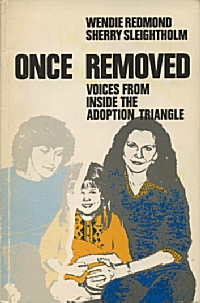
Once Removed:
Voices From Inside the
Adoption Triangle
by Wendie Redmond and
Sherry Sleightholm
McGraw-Hill Ryerson, 1982
Reviewed by Barbara Free
There are, or were, at the time the book was written, some significant differences between Canadian and U.S. adoption laws, in that Canadian adoptive families were given an Order of Adoption, which listed the birth mother’s complete name and the adoptee’s original name. Such a small difference would make searching for a birth parent much easier for many persons than the usual U.S. system of having names deleted or blacked out, and having nothing with birth parents’ names, or having only the amended birth certificate, although the documents and information available to adoptive parents and adoptees seems to differ greatly, not only from state to state, but from one agency to another, one lawyer to another, one social worker to another. Some may think all of this irrelevant now, with open adoptions, but there are still millions of persons in both the U.S. and Canada who were affected by closed adoptions, and closed adoptions do still take place. Furthermore, what is termed open adoption may still not provide everyone involved with full names and information, let alone free access to everyone in both families. Another difference in Canada, at least in 1982 and in the authors’ experience, appears to be that birth mothers were not interested in searching, were still hiding and not wanting to be found, and in many cases, had not ever told subsequent spouses or offspring that they had relinquished a child. Some of the women written about in this book agreed only to clandestine meetings or letters with their relinquished son or daughter, because they were still afraid to tell a spouse. Although this book will not give the reader a very optimistic view of reunions, and it does tend to focus on initial reunions or early reunion relationships, it does give valuable insight into the way society was in the early ’80s, when some of today’s young adult adoptees were born, and of the way things had been earlier, when many of today’s searchers were born.
Sometimes, when one is beginning a search, it is easy to get caught up in the drama of wonderful stories of reunion, either on TV or even in support groups, and develop unrealistic expectations of a short search and “happily ever after” reunions. While one always hopes for those happenings for others, part of successful relationships in reunion seems to be realistic expectations, not of fairy tale permanent euphoria, but not of conflict and disappointment, either. The variety of stories in this book will help the reader have a fuller picture of various possibilities. For the reader not currently involved in search, the stories read like intriguing short stories, as exciting as any fiction, yet true stories with only identifying details changed.
At the next O.I. meeting, look over some of the older books and pick out one to explore. Many of them are still valuable resources for anyone affected by adoption.
Excerpted from the July 2003 edition of the Operation Identity Newsletter
© 2003 Operation Identity